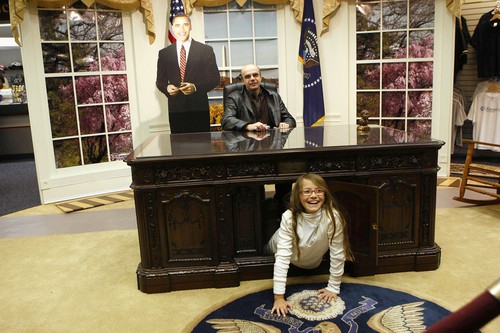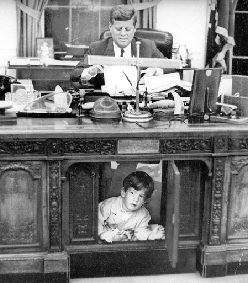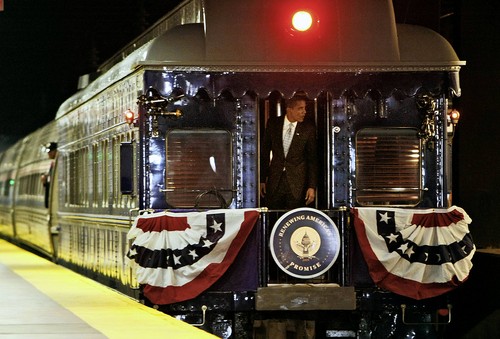The presidential inauguration is a time of new beginnings, but it cannot avoid comparisons with the past. Indeed, a time of transition places a special premium on the past. Speech writers, pundits, retailers, and ordinary citizens have been trying out various comparisons and narratives to place the historic event in its proper perspective. This attempt to make sense of collective life includes notable images as well. Images such as this one:
As dad sits at the president’s desk in this faux Oval Office, his daughter pops out of the door in the front, neatly reprising the famous image of John-John Kennedy doing the same in 1963.
Dad forgot to pretend to be reading, but then he is on vacation–all the way from Italy, in fact. The Kennedy image apparently has global appeal, and the Oval Office replica probably is doing a brisk business in the run-up to the inauguration. The cardboard cutout of Obama standing behind the desk will be there to help sell the photo-op as a fitting part of the inaugural festivities, but it does more as well. The future president is already there in spirit, as if waiting to sit down and get to work once the public has had its fun. The image makes it easy to believe that the administrative transition between past and present will be as seamless as shifting one’s attention from the replica to the real thing.
The insertion of Obama into one of the stock scenes of the visual history of the Kennedy presidency has other implications as well. Many a commentator has been pushing the Camelot analogy, and there are indeed many similarities between JFK and Obama, including both eloquent oratory and skill at manipulating the media. Kennedy’s photo-op with John-John for Look magazine was no accident, and Obama has not been innocent of selective encouragement of the comparison with his classy predecessor. At the end of the day, however, I think that the Obama-Kennedy comparison is largely kitsch. That’s why the first photo above is perfect, as it captures the analogy exactly as it is–a cheap form of popular entertainment that should be played for laughs rather than taken seriously.
To put it bluntly, I can think of one very good reason why I don’t want to see that analogy become significant, and others as well. Oval Office replicas are not going to shape history, of course, but historical analogies can shape the way we understand the world and evaluate leadership. Images of the presidency can have historical resonance which in turn can guide collective efforts at renewal. That’s why I like this image:
This photograph of Obama at the back of his inaugural train is hardly innocent of strategic design on his part. The train ride is a trip down memory lane to influence public understanding of what lies ahead. The conjunction of the slogan on the seal–Renewing America’s Promise–with the largely abandoned technology of passenger rail travel speaks volumes. Individual comparisons with Lincoln or Roosevelt or Truman are the least of this image of a gleaming railroad car decked with patriotic bunting. This renewal will include restoration of traditional values such as personal discipline and public service, decision-making conducted in a deliberative manner, and government programs addressing collective needs.
Renewing America’s Promise at the back of a railroad car is nothing less than a commitment to using whatever works to sustain American democracy. All this is possible, of course, because the black man at the back of the train will be the president, not the porter. Now that the oppression that also was part of that old order can be discarded, renewal through restoration can begin.
Thus, we have two images and two senses of a usable past: With the one, kitsch and the undertow of tragedy. With the other, the possibility that what was best about the past can, finally, be restored now that so many prior failings can at last be left to history.
Photographs by Nancy Stone/Chicago Tribune; Stanley Tretick/Look Magazine; Pablo Martinez Monsivais/Associated Press.
Update: Thanks for the cross-post at BAGnewsNotes. To see an earlier NCN post on another Oval Office replica, go here.



[…] Hariman has an interesting post (cp’d at the Bag) titled, Visual Histories: Framing the Obama Presidency. He begins by examining “the insertion of Obama into one of the stock scenes of the visual […]
Yes, the images are rich–he’s the President not the porter. Another fun coincidence of history: you know it was Brotherhood of Sleeping Car Porters’ A. Philip Randolph’s 1940s idea for a March for Jobs & Freedom that ended up postponed until 1963 and is now recalled as the “I have a dream” march on Washington. There are many, many connections.
And, as a point of clarification: Train travel is actually increasing at levels beyond even Amtrak’s dreams. So to describe “the largely abandoned technology of passenger rail travel” is inaccurate. (from the American Public Transportation Association: In 2006, Americans took 10.1 billion trips on public transportation – the highest ridership level in 49 years. Thirty-four million times each weekday, people board public transportation. From 1995 through 2006, public transportation ridership increased by 30 percent, a growth rate higher than the 12 percent increase in US population and higher than the 24 percent growth in use of the nation’s highways over the same period.)
Train travel is far more sustainable a transportation option than air or private cars, and is in many ways the future for an environmentally friendly and economic feasible mode of travel for many in the US. (and hey, Biden’s already a fan) So Obama, even at the back of a train, is really heading toward the future.
[…] in democratic culture, has an interesting related post from yesterday (cp’d at BNN) titled, Visual Histories: Framing the Obama Presidency. He begins by examining “the insertion of Obama into one of the stock scenes of the visual […]